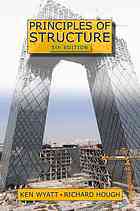

Most ebook files are in PDF format, so you can easily read them using various software such as Foxit Reader or directly on the Google Chrome browser.
Some ebook files are released by publishers in other formats such as .awz, .mobi, .epub, .fb2, etc. You may need to install specific software to read these formats on mobile/PC, such as Calibre.
Please read the tutorial at this link. https://ebooknice.com/page/post?id=faq
We offer FREE conversion to the popular formats you request; however, this may take some time. Therefore, right after payment, please email us, and we will try to provide the service as quickly as possible.
For some exceptional file formats or broken links (if any), please refrain from opening any disputes. Instead, email us first, and we will try to assist within a maximum of 6 hours.
EbookNice Team

Status:
Available0.0
0 reviews
ISBN 10: 1742246966
ISBN 13: 9781742246963
Author: Ken Wyatt, Richard Hough
Since its first publication in 1974, Principles of Structure has established itself at the forefront of introductory texts for students of architecture, building and project management seeking a basic understanding of the behavior and design of building structures. It provides a simple quantitative introduction to structural engineering, while also drawing connections to real buildings that are more complex. Retaining the style and format of earlier editions, this Fifth Edition brings the text and examples into alignment with international practice. It also features six new buildings from around the world, illustrating the principles described in the text. The book begins with a chapter explaining forces and their effects. Other chapters cover ties and struts, loadings, graphical statics, bracings, shears and moments, stresses, deflections, and beam design. There is also an appendix with a fuller explanation of fundamentals for readers unfamiliar with the basic concepts of geometry and statics. The book offers a unique format with right-hand pages containing text and left-hand pages containing complementary commentary including explanations and expansions of points made in the text and worked examples. This cross-referencing gives readers a range of perspectives and a deeper understanding of each topic. The simple mathematical approach and logical progression—along with the hints and suggestions, worked examples and problem sheets—give beginners straightforward access to elementary structural engineering.
Chapter 1 Forces, Moments and Equilibrium
1.1 Forces on Structures
1.2 Measurement of Force
1.3 External Forces
1.4 Resultants and Components
1.5 Moments
1.6 Couples
1.7 Equilibrium
1.8 Co-Planar Forces
1.9 Concurrent Force Systems
1.10 Forces at Supports
1.11 Stability and Determinacy
1.12 Parallel Force Systems
1.13 Internal Forces
Application: Concurrent Forces, Hong Kong and Shanghai Bank
Chapter 2 Ties and Struts
2.1 Pressure
2.2 Stress
2.3 Types of Stress
2.4 Strain and Elasticity
2.5 Design of Tension Elements (Ties)
2.6 Ties and Struts
Application: Ties and Struts, Il Grande Bigo
Application: Struts and Ties, Kurilpa Bridge
Chapter 3 Loadings on Buildings
3.1 Loads
3.2 Dead Loads
3.3 Live Loads
3.4 Wind Loads
3.5 Other Loads
3.6 Calculation of Loads
Application: Loading, Live Loads
Chapter 4 Graphical Statics
4.1 Vectors
4.2 The Triangle of Forces: Resultants and Equilibrants
4.3 Bow’s Notation
4.4 The Triangle of Forces: Two Unknown Forces
4.5 Concurrency of Forces
Application: Graphical Statics, Patscentre
Chapter 5 Pin-Jointed Structures
5.1 Pin-Ended Members
5.2 Graphical Method
5.3 Method of Joints
5.4 Method of Sections
5.5 Summary
Application: Roof Trusses, Menil Collection Museum
Application: Pin-Jointed Trusses, Raleigh-Durham Airport
Chapter 6 Bracing of Buildings
6.1 Vertical and Lateral Loads
6.2 Basic Systems
6.3 Bracing Options
6.4 Asymmetry
6.5 Combined Effects
Application: Bracing, Osaka International Conference Centre
Application: Bracing, China Central Television
Chapter 7 Shear Force and Bending Moment
7.1 Terms
7.2 Shear Force
7.3 Bending Moment
7.4 Bending Moment Diagrams
7.5 Load, Shear Force and Bending Moment
7.6 Contraflexure
Application: SFD, BMD, Red Centre
Chapter 8 Properties of Area
8.1 Centre of Gravity
8.2 The Centroid
8.3 Second Moment of Area
8.4 Theorem of Parallel Axes
8.5 Common Centroid Theorem
8.6 Section Modulus
Application: Properties of Cross Sections, Sydney Opera House
Application: Properties of Cross-Sections: National Stadium, Beijing
Chapter 9 Bending Stresses
9.1 Internal Effects
9.2 The Stress Formula
9.3 Deductions
9.4 Stress Variation
9.5 Maximum Stress
9.6 ‘Ultimate’ Conditions
Application: Beams in Bending, Phoenix Central Library
Chapter 10 Shear Stresses
10.1 Horizontal and Vertical Shear Stress
10.2 Shear Stress Formula
10.3 Maximum Shear Stress
10.4 Deductions
10.5 ‘Ultimate’ Conditions
Application: Design for Shear, Cummins Engine Factory
Application: Design for Shear, Serpentine Pavilion 2005
Chapter 11 Deflections
11.1 General Rules
11.2 Deflection Formula
11.3 Spans and Materials
11.4 Deflection Sensitivity
11.5 Dynamics
Application: Controlling Deflections, Commerzbank Headquarters
Chapter 12 Design of Beams
12.1 Analysis and Design
12.2 Design of a Simple Beam
12.3 Design Steps
12.4 Ultimate Strength Design
principles of structure
4 structures
understanding the principles of organic chemistry a laboratory course
principles and practice of structural equation modeling 4th edition pdf
structure and principles of the constitution
3 principles of chemistry
3.1 structures and principles of the constitution
Tags: Ken Wyatt, Richard Hough, Principles, Structure